This Week's Show
Air Date: January 2, 2026
FULL SHOW
SEGMENTS

Out-of-this-World Discoveries from 2025
View the page for this story
2025 brought some exciting extraterrestrial scientific discoveries that might have been missed amid other headlines. Hosts Aynsley O’Neill and Jenni Doering discuss new evidence about the Martian environment and the possibility of past life on Mars, the discovery of important building blocks of life in samples from the asteroid Bennu, and observations of the third interstellar object that’s been documented in our solar system. (09:34)
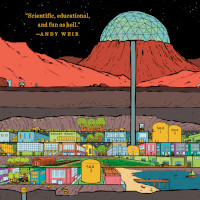
A City on Mars and the Perils of Settling Space
View the page for this story
As a new space race heats up, private companies and sovereign nations alike have their sights on setting up permanent human settlements in space – but huge technological, medical and legal challenges remain. Biologist Kelly Weinersmith and cartoonist Zach Weinersmith are a married couple who teamed up to write the 2023 book A City on Mars: Can We Settle Space, Should We Settle Space, and Have We Really Thought This Through? They join Host Jenni Doering to chat about the comically hostile environments beyond our home planet. (20:06)
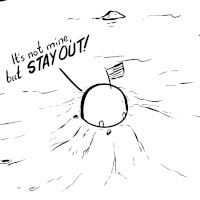
A City on Mars and the Perils of Settling Space (Cont'd)
View the page for this story
A City on Mars authors Kelly and Zach Weinersmith continue their conversation with Host Jenni Doering about the challenges of settling space. They discuss why the Moon has limited “primo” real estate, what it was like to write this book together as a married couple, and why they view humor as an essential piece of helping a general audience understand such complex issues as international space law. (17:31)
Show Credits and Funders
Show Transcript
260102 Transcript
HOSTS: Jenni Doering, Aynsley O’Neill
GUESTS: Zach and Kelly Weinersmith
[THEME]
O’NEILL: From PRX – this is Living on Earth.
[THEME]
O’NEILL: I’m Aynsley O’Neill.
DOERING: And I’m Jenni Doering.
The future of space exploration and the big hurdles to settling space.
KELLY WEINERSMITH: As sci-fi geeks, we were super excited that space settlements were just around the corner, so we decided to write the guide to the next decade of humans settling space. And that's not the book we wrote, because about two years in, we were like, "Oh man, there's so much more than just sending mass to space.”
O’NEILL: There’s a lot of talk about putting humans on the red planet but it’s easier said than done.
ZACH WEINERSMITH: Mars has a very thin atmosphere, which means if you go outside, you die. It's about 1% Earth's atmosphere. It's made of carbon dioxide, mostly. That thin atmosphere also means you're very exposed to radiation from space, and you know, one way to think about it is we really take for granted all the stuff Earth does, right? You don't worry most of the time that if you go outside, you're breathing something that might kill you.
O’NEILL: That and more, this week on Living on Earth. Stick around!
[NEWSBREAK MUSIC: Boards Of Canada “Zoetrope” from “In A Beautiful Place Out In The Country” (Warp Records 2000)]
[THEME]
Out-of-this-World Discoveries from 2025

Mars is a desert planet, but its rock formations suggest the planet may have had liquid water in the past. As one of our closest planetary neighbors, Mars is a hotbed of scientific discovery beyond Earth. (Photo: NASA, Wikimedia Commons, public domain)
DOERING: From PRX and the Jennifer and Ted Stanley studios at the University of Massachusetts, Boston, this is Living on Earth. I'm Jenni Doering.
O'NEILL: And I'm Aynsley O'Neill. And Jenni, I haven't seen you since last year, so first things first, happy 2026!
DOERING: Yes, Happy New Year, Aynsley! I can't believe we're leaving 2025 behind already, but before it shrinks too much in the rear-view mirror, let's take a moment to look back on some exciting recent news about space that I think we probably all might have missed.
O'NEILL: Jenni, I am chomping at the bit to bring you this because 2025 had some really cool advancements in the world of space science, especially when it comes to one of our closest planetary neighbors, Mars, and being the space nerd I am, I am jumping at the opportunity to share them with you.
DOERING: Well, I will never deny you the opportunity to nerd out about space. So what you got for us?
O'NEILL: So to start, just like our home planet, the Martian surface occasionally plays host to dust devils, these swirling whirlwinds that form when hot air rises quickly and starts to spin. And on Mars, these can get huge. I'm talking absolutely massive. One reached even over a mile in height. And we've known about them since the 80s, but in 2025 scientists confirmed the existence of electrical activity in those dust devils, just like we sometimes get here on Earth.

It turns out “dust devils” on Mars, swirling whirlwinds that form when hot air rises quickly, sometimes contain electrical activity, according to 2025 research. (Photo: NASA/JPL-Caltech/SSI, Wikimedia Commons, public domain)
DOERING: What? You mean, like lightning on Mars?
O'NEILL: Well, okay, so pop science has been calling them "mini lightning strikes," but the research article itself uses the technical term, "triboelectric discharges," which I had to look up, but it's the kind of electric activity that's generated from friction. And if you listen to the sounds that the perseverance rover recorded, to me, it definitely sounds closer to a static shock. I'll play it for you. It's pretty subtle, so you should listen close.
[SFX triboelectric discharges]
DOERING: Oh yeah, actually, it's taking me back to being at the science museum as a kid, and you know those metal spheres that you could put your hand on and it would make your hair stand on end?
O'NEILL: Yes, yes, yes. Exactly makes me think of that.
DOERING: Yeah, and like the crackling sounds...All right, but I thought that we did know that there was lightning on other planets, not just our own. So what's exciting about the fact that there's lightning on Mars?
O'NEILL: Well, you're right. So there are lightning storms on planets like Jupiter and Saturn, but this confirms that the Martian atmosphere can become electrically charged, and that knowledge can help us learn more about the kinds of chemical reactions that could naturally occur on the surface of the planet.
DOERING: Oh, okay. I mean knowing about possible lightning strikes also seems like it would be really important for like, the stuff we're sending up there, rovers, any future human habitats or exploration, pretty important to know if you're going to get zapped. But I know there's a ton of space science that we're looking at on Mars, and I just love hearing about what we're learning about whether life ever existed there. So Aynsley, you know, did 2025 bring us any closer on that front?
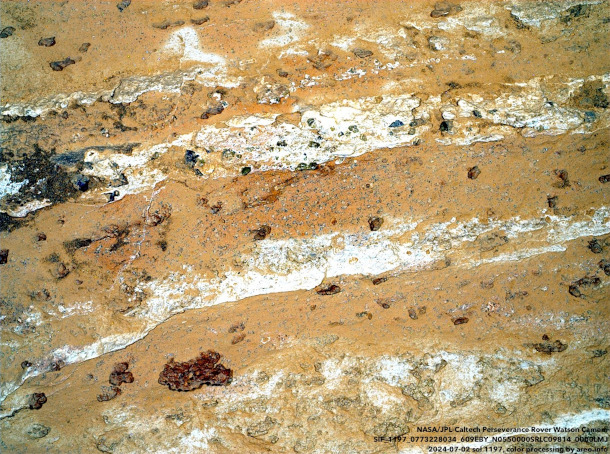
An image taken by the Perseverance Rover at the Cheyava Falls boulder site on Mars. A rock sample collected by the rover, nicknamed “Sapphire Canyon,” appears to show patterns associated with microbial activity and compounds that usually form in the presence of life. It’s not yet a confirmation, though, of a history of life on Mars. (Photo: color processing by areo.info, raw data by NASA/JPL-Caltech, Wikimedia Commons, CC BY 4.0)
O'NEILL: I feel like every year we get a little closer to finding out. There's been pretty exciting news. Researchers have been studying the rocks on Mars, because God knows, if there's one thing Mars has, it's rocks, and they've noticed what they called a “potential biosignature” in this sample that they nicknamed “Sapphire Canyon.” And to be clear, when I say “potential biosignature,” the word “potential” does a lot of heavy lifting there.
DOERING: Okay, but hold up. I thought we hadn't actually gotten any rock samples back from Mars yet, because it's just really hard to do that. So how exactly did researchers determine this?
O'NEILL: We come back once again to our trusty rover friend, Perseverance, here. There are a lot of things that scientists can do from afar, thanks to that rover, which has all these little science instruments on there, doing some really cool research on these rocks. And what scientists were really interested in for this particular rock was these speckles that kind of look like colorful leopard spots?
DOERING: Wait a minute, how much like leopard spots?
O'NEILL: Okay, it's really not as orange as or as uniform as actual leopard print would be. But if you look, they're lighter tan specks that are ringed by these darker grayish lines, so you could see where the connection was made. And these patterns are, at least here on Earth, typically associated with microbial activity. So that's pretty interesting. And to top it off, the Martian rock also showed signs of organic compounds, which are the chemical building blocks of life. So altogether, it's pretty close to what we would expect to see if microbial life had gotten onto that rock and started eating up its organic carbon, sulfur and phosphorus for energy.
DOERING: Oh, wow. And, you know, we've known for a while now that liquid water probably once flowed on the surface of Mars. So we've got water, we've got what seems to be these signs of microbes consuming energy, it sounds a lot like life as we know it.
O'NEILL: I know, it feels like it's all coming together, but it's not quite a smoking gun. The minerals on the rock are often tied to biological processes, but it's hard to entirely rule out that they may have been caused without life being involved, but it seems like it raises the likelihood that some kind of life might have been involved here, and for that reason, it's one of the most exciting developments for astrobiologists in recent years.
DOERING: Wow, so cool. So I know we're looking for life in a lot of different places around our solar system. And I actually did hear that there's been some new science along these lines out of the asteroid Bennu. Do you know what I'm talking about?
O'NEILL: Oh, Jenni, I love the asteroid Bennu. We owe so much to the asteroid Bennu. You'll remember that I did an interview with Dr. Vicky Hamilton about this back in 2023. She was a part of this OSIRIS-REx mission that, as opposed to Mars, actually has brought back samples from the asteroid.
DOERING: Yes.
O’NEILL: And ever since, scientists around the world have been studying those samples pretty intensely. And I think the new science that you're talking about, maybe those sugar molecules, Jenni?
DOERING: Yes, you're jogging my memory. Yeah, I watched a YouTube video about this, but tell me more.
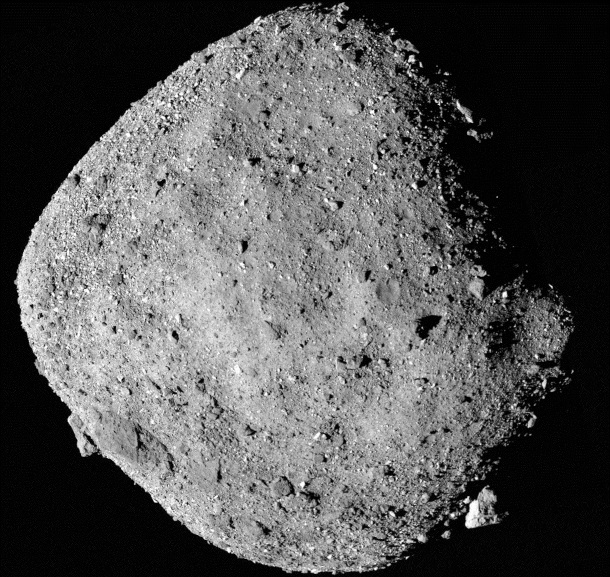
A Japanese research team discovered examples of ribose and the first ever extraterrestrial example of glucose on the asteroid Bennu. (Photo: NASA/Goddard/University of Arizona, Wikimedia Commons, public domain)
O'NEILL: Okay, so there was this Japanese team that found examples of ribose, as well as the first ever extraterrestrial example of glucose, and both of those are sugars that are massively important for biology on Earth, ribose is a part of DNA and RNA, and of course, glucose is one of the key building blocks of food for many organisms, including ourselves, and other samples from Bennu have also shown signs of some of life's other building blocks. We're talking amino acids, nucleobases, carboxylic acids, all this stuff that helps life as we know it work together.
DOERING: Wow. Okay, so again, maybe not a smoking gun, but I think it really shows that some of the key ingredients are there and like throughout the solar system.
O'NEILL: I know. Even on an asteroid. I think that since living on Earth is our only real blueprint for how life works, it's pretty easy to think that any other life would also be found on a planet like ours. I know we're looking at Mars, I know we're looking at some of Jupiter's moons, but finding sugars and amino acids even on an asteroid really is opening my mind to all the possibility that's out there.
DOERING: Wow. And when you think about how many asteroids are out there, this is really kind of mind blowing,
O'NEILL: And how much out there is out there. Jenni, I've actually got one more piece of news from our third ever interstellar object that was observed. So our third ever visitor from outside the solar system.
DOERING: Oh yeah, I have seen some headlines about this. So what can you tell me?
O'NEILL: Well, so the first one was only discovered in 2017. That was called 1I/ʻOumuamua. And following that naming pattern, this is 3I/ATLAS, which we only saw last summer, coming in as a comet from another solar system.
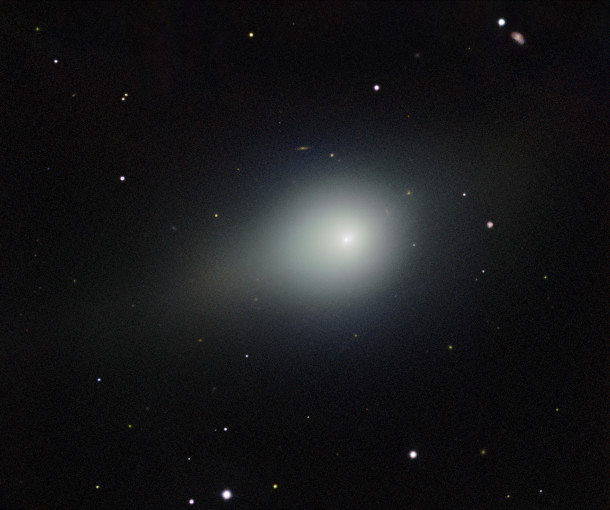
The interstellar comet, 3I/ATLAS, captured by the Gemini Multi-Object Spectrograph. (Photo: Processed by J. Miller, M. Rodriguez, T.A. Rector, M. Zamani, International Gemini Observatory/NOIRLab/NSF/AURA/B, Wikimedia Commons, CC BY 4.0)
DOERING: Oh, my gosh. So what do we know about this interstellar visitor? Could it be aliens?
O'NEILL: Oh, people were definitely thinking aliens. With each of these, 1I/ʻOumuamua and 3I/ATLAS, every single one, people are going, "Aliens"? But as far as we can tell, no, not yet. This is just a sort of classic comet with a solid ice core and a tail coming off the end. It's picture perfect, Jenni.
DOERING: Well, it sounds pretty. Can I look up in the night sky? Can I see this thing?
O'NEILL: All right, not with your naked eye, Jenni. You're gonna need a telescope, or we've got some pictures that we'll be sure to post on the website. But it came closest to Earth last year, December 19, and it's still in the solar system, so we're still observing it, but it'll be headed past Jupiter in March. So we got to get our science in now, because once it's gone, it's gone.
DOERING: Wow. This is it. One chance. And I know that, you know, scientists are probably going to be poring over that data for months and years to come. So I'm sure you'll keep us posted on what they find.
O'NEILL: Well, Jenni, you know me, so you can rest assured, I will be paying attention to all the space science that's coming up soon.
DOERING: And maybe someday we'll send you on assignment to Mars.
O'NEILL: Mars! Jenni, oh my gosh, don't tempt me like this.
DOERING: Well, we can dream. Well, thanks as always, Aynsley, this has been really fun.
O'NEILL: Thank you, Jenni.
Related links:
- NASA | “NASA Rover Detects Electric Sparks in Mars Dust Devils, Storms”
- NASA | “NASA Says Mars Rover Discovered Potential Biosignature Last Year”
- Nature Geoscience | “Bio-Essential Sugars in Samples From Asteroid Bennu”
- Space.com | “Farewell, Comet 3I/ATLAS! Interstellar Visitor Heads for the Outer Solar System After Its Closest Approach to Earth”
DOERING: And we'll be back after a short break to talk about the possibilities and the big challenges of us humans someday expanding beyond our home planet. Keep listening to Living on Earth.
[MUSIC: Gustav Holst, Berliner Philharmoniker, Herbert von Karajan, “The Planets, Op. 32: IV. Jupiter, the Bringer of Jolity, Deutsche Grammophon GmbH, Berlin]
ANNOUNCER: Support for Living on Earth comes from the Waverley Street Foundation, working to cultivate a healing planet with community-led programs for better food, healthy farmlands, and smarter building, energy and businesses.
[CUTAWAY MUSIC: Gustav Holst, Berliner Philharmoniker, Herbert von Karajan, “The Planets, Op. 32: IV. Jupiter, the Bringer of Jolity, Deutsche Grammophon GmbH, Berlin]
A City on Mars and the Perils of Settling Space

Authors Kelly and Zach Weinersmith combined their science and science-fiction interests and created a book on space exploration, with the intention of taking a complicated set of topics and making it fun and engaging. (Photo: Courtesy of Penguin Press)
O’NEILL: It’s Living on Earth, I’m Aynsley O’Neill.
DOERING: And I’m Jenni Doering.
Fewer than a thousand humans have ever been to space, and no one has yet traveled beyond the Moon. But as a new space race heats up, private companies and sovereign nations alike have their sights on sending humans to Mars and beyond and setting up permanent settlements in space. That’s easier said than done, since we’re adapted to the atmosphere, climate, geology, ecology, gravity and more of this planet, Earth. Well, a fascinating and at times hilarious book from 2023 takes a deep dive into everything we’re gonna need to figure out to make long-term life in space feasible. The title is A City on Mars: Can We Settle Space, Should We Settle Space, and Have We Really Thought This Through? And it’s written by Zach and Kelly Weinersmith, a married couple who team up to write popular science books. Dr. Kelly Weinersmith teaches biosciences at Rice University and is the co-host of the podcast Daniel and Kelly’s Extraordinary Universe. And Zach is a professional cartoonist who you might know from his webcomic Saturday Morning Breakfast Cereal. Though their book A City on Mars does explore the feasibility of settling the red planet, it takes a big picture look at the technological, medical and even legal challenges of settling space in general, whether that’s on Mars, the Moon or permanent floating space stations. Kelly and Zach Weinersmith are here with us now—welcome to Living on Earth!
KELLY WEINERSMITH: Thanks so much for having us.
ZACH WEINERSMITH: Thanks for having us.
DOERING: So how did you get interested in this space settlement conversation?
KELLY WEINERSMITH: Well, we are both sci-fi geeks, and we wrote a book together called Soonish: Ten Emerging Technologies That'll Improve and/or Ruin Everything. And in that book, there were two chapters related to space, one about cheap access to space, and the idea there was that SpaceX is dropping the cost of launching mass to space. And another chapter about asteroid mining, the idea there being we can go to asteroids and extract things like metals. And both of those communities were telling us that, like these are the keys that you need to unlock space settlements. So space settlements are just around the corner because we can send the habitats that we need up to space, and we can get the other resources we need from asteroids. And as sci-fi geeks, we were super excited that space settlements were just around the corner, so we decided to write the guide to the next decade of humans settling space. And that's not the book we wrote, because about two years in, we were like, "Oh man, there's so much more than just sending mass to space."
DOERING: [LAUGHS] Yeah, Zach, that must have been a little bit of a surprise to find that you guys were taking a little bit of a different approach than you had first envisioned.
ZACH WEINERSMITH: I'm sure it was for our editor. [LAUGHS] I remember it as if it were like a single kitchen table conversation, but like we were both doing these crazy amounts of research, and for a big research project, it takes a while for the picture to resolve. And I think it was about two years in, we'd been talking, and slowly the conversation had steered toward a like, "Maybe this isn't going to happen. Maybe this, there are parts of this that shouldn't happen." And so we decided, as we come back to our editor, or maybe she came to us first. I think we kept changing the chapters to be more toward this, but we were trying to keep a neutral stance. And at some point she was like, "Clearly, your thesis has changed. Could you please make the book reflect that?"
DOERING: [LAUGHS]
KELLY WEINERSMITH: [LAUGHS]
ZACH WEINERSMITH: And so we did, and once that was sort of intellectually open to us, then we could kind of, I don't want to say building a case. I think we tried to be as neutral as possible. But like, have a picture that wasn't completely enthusiastic.
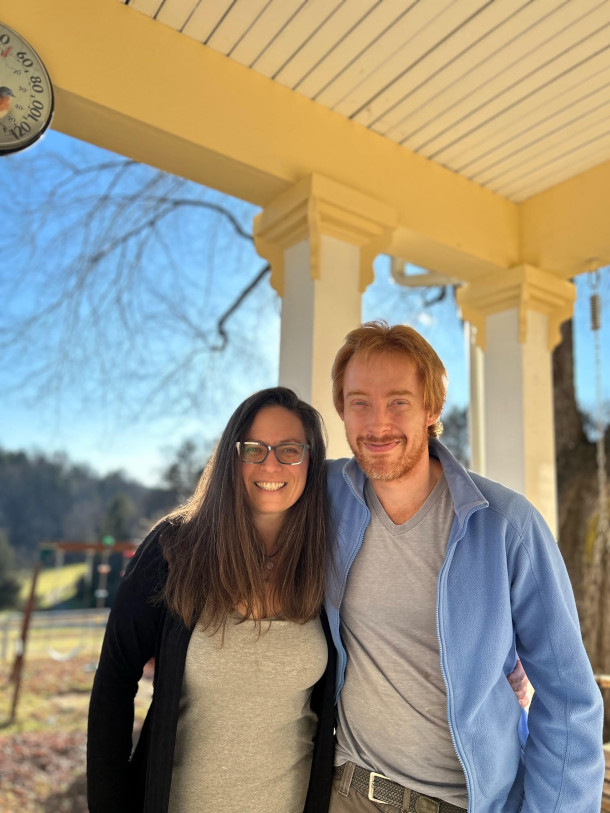
Kelly and Zach Weinersmith are the co-authors of A City on Mars: Can We Settle Space, Should We Settle Space, and Have We Really Thought This Through? (Photo: Courtesy of Zach and Kelly Weinersmith)
DOERING: Of course, you had to change tack partway through this project, and your book opens with a dedication that reads in part, "To the space-settlement community. We worry that many of you will be disappointed by some of our conclusions, but where we have diverged from your views, we haven't diverged from your vision of a glorious human future." So tell me about your relationship with the space-settlement community.
KELLY WEINERSMITH: We get invited to fewer space parties these days—
ZACH WEINERSMITH: [LAUGHS]
KELLY WEINERSMITH: But they've been actually really good sports for the most part, so that, you know, there are a couple people who are very angry at the book and very angry at us, but for the most part, we keep getting invited to space-settlement conferences to present our take on things. And we're usually presented as the like, "All right. Here's the segment that no one really wants to hear, but here's a reality check, and then we'll go back to being optimistic and amazing once the Weinersmiths leave the room." But they've been welcoming and nice to us.
DOERING: You guys are kind of the skunk at the picnic, I guess in some sense.
ZACH WEINERSMITH: Yes.
KELLY WEINERSMITH: Yeah, yeah, we are.
DOERING: Well, the subtitle of your book, A City on Mars, includes the line, "Have We Really Thought This Through?", which I think says it all. So, let's get right to the point. Just how inhospitable is Mars?
ZACH WEINERSMITH: Mars is bad. So let me just go down the line quickly. Mars has a very thin atmosphere, which means if you go outside, you die. It's about 1% Earth's atmosphere. It's made of carbon dioxide, mostly. That thin atmosphere also means you're very exposed to radiation from space. That's compounded by the fact that Mars is very weakly magnetic. So on Earth, we have this magnetosphere, so that when all these nasty bits of radiation, these hot ions, come from the sun, the magnetosphere bottles them up, delivers them to the poles and gives us a light show. Mars doesn't do that. In addition, Mars has about 40% Earth gravity. That's probably bad. But, to be honest, we don't really know. Most of our data on humans off Earth is in zero gravity on the International Space Station. And, you know, weird things happen at zero, so we don't know what 40% is like. The surface is laden with a chemical called perchlorates used in dry cleaning. We don't have a lot of data on long-term high-level exposure in humans, but we know exposure to it disrupts thyroid hormones. So that's not ideal, especially not ideal if at some point in this conversation, we talk about reproduction. I do want to emphasize though, like, Mars is the best place. Mars, Mars, Mars is the best option.
DOERING: [LAUGHS] Why is that?
ZACH WEINERSMITH: Well, you could say because everywhere else is worse. Look, if you're on Mars, here are the upsides. One, there is, by space standards, readily available water, not Earth-available, but available. So like the Poles have lots of water ice. It appears that if you dig down far enough at many, even most places on Mars, you eventually get to some water that you can access. Mind you, it has to be cleaned, which is not ideal, compared to Earth, where you it's much easier to get access to water, but it's there. And so water, if you do a little chemistry on it, it's not just water for you to drink and shower and have water balloon fights. It's like... you can crack it into hydrogen and oxygen, which doesn't just mean you get oxygen, which we like to breathe. It also means, you know, hydrogen and oxygen are some of the best rocket propellants when you combine them. If you can get access to water, you've done a lot of the job. In addition, Mars has like the elemental buffet needed to survive. It's made of roughly Earth-like proportions of stuff. And that matters because the best alternative, which is the moon, is not. The moon is poor in all sorts of stuff. So one way to say it would be, Mars gives you a chance, almost everywhere else, not really.
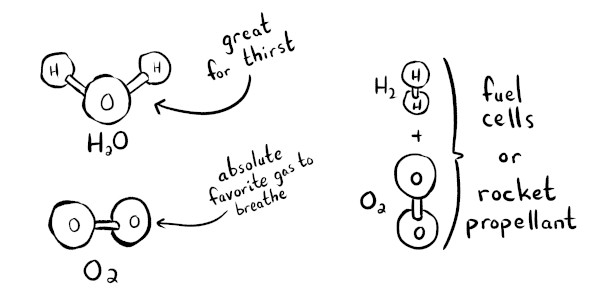
In the right circumstances and with the right kind of chemical reactions, water can be utilized not only for drinking and bathing, but also for manufacturing oxygen and rocket propellants. (Image: Drawn by Zach Weinersmith)
DOERING: You know, one of the subheadings in your book is, “The Sun Wants to Kill You,” and then the next one is, “The Whole Universe Wants to Kill You, Actually.” So part of that is radiation. Can we just back up a little bit and talk about like, why is space so dangerous when it comes to radiation?
ZACH WEINERSMITH: Yeah, so it's actually a bit of a nuanced picture. So first of all, the sun is just kicking out dangerous radiation all the time. And there's also another source of radiation called galactic cosmic radiation that isn't completely understood, but just if you want to visualize lots of heavy ions zooming through space, crisscrossing your body all the time, that's what space does. Now, you know, we hasten to say, it feels like sometimes people talk about this like it's going to kill you instantly. It's much more like it's going to probably, non-trivially, increase your risk of cancer.
DOERING: Yeah.
ZACH WEINERSMITH: You know, we actually really tried to dig into this, because it's complicated to know what the effects of radiation in space are on humans because humans don't normally experience this. Astronauts haven't been up that long. I think the record total for an astronaut is something like 800 something days, and the record consecutive total is 437 days. Most astronauts much shorter. So we have really limited data. The data we do have on radiation on Earth comes from like disaster sites, things like Hiroshima and Nagasaki, times something really bad happened. But that's obviously not equivalent to the kind of radiation you get in space. So we don't actually know that much. In addition to all that, the sun, from time to time, just sort of belches out these sprays of radiation, like we call it a flashlight beam of doom.
DOERING: [LAUGHS]
ZACH WEINERSMITH: Your best defense against this is that space is big, so it probably won't hit you, but it could happen. You know, if it happened while you were in a spaceship and you didn't have a lot of protection, you would just die, and you would die in one of the worst ways imaginable, which is acute radiation sickness. There are also cases from history when the sun shot one of these at Earth. So we document a few of these cases in the book. But essentially what happened is, you know, these stories about like the telegraph era, telegraph machines are suddenly like firing sparks around the world. There are strange lights in the skies. And you know, we haven't really experienced this in a technologically developed world where it would probably be quite bad, but manageable. But if you imagine you're in a habitat on Mars and you're deeply dependent on technology, it's much more scary, which is why you will be underground.
DOERING: Oh my. What was that phrase? “Flashlight…” [LAUGHS]
ZACH WEINERSMITH: “Flashlight beam of doom.”
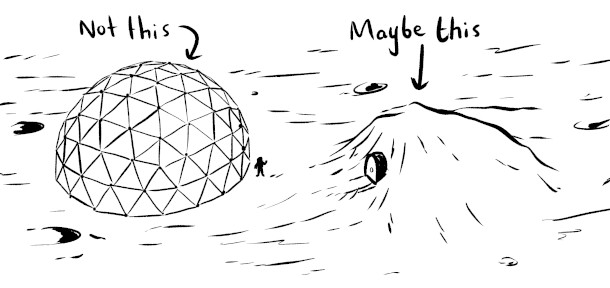
Because of the dangerous amounts of radiation from the Sun and outer space that reach the surface of Mars, human habitats would likely need to be underground and covered by dirt. (Image: Drawn by Zach Weinersmith)
DOERING: Wow. Kelly and Zach, your book covers three main areas of study that need to advance for humans to settle space: technology, medicine and the law. Let's start with the first one. Technologically speaking, how far away are we from being able to build a space settlement community?
KELLY WEINERSMITH: I'd say we're pretty far. Space is a really difficult environment to do engineering in. The surface of the Moon and Mars are covered with this fine, jagged dust called regolith. And Zach already talked about this a little bit. It's got those perchlorate chemicals in it, but they're going to sort of grind up the equipment that you want to use. Additionally, we have to worry about how we're going to get power out there. So Mars, every once in a while, has planet-wide dust storms that last for like, weeks at a time, and so you're not going to want to rely on solar power. So we're probably going to need portable nuclear reactors, and folks have been working on these, but they're not quite scaled up to the level that they could sustain a settlement. But another big technological problem is that we haven't really established habitats that can recycle a ton of stuff. So you know, Zach talked about how hard it's going to be to get water on Mars. And on the International Space Station, we've gotten pretty good at recycling water. And, in fact, the astronauts refer to the water that they're drinking as yesterday's coffee because even the urine gets recycled. So we have some experience with that, but we don't have experience with recycling a lot of other stuff. So ideally, you would have plants that are both food and the method for extracting carbon dioxide out of the atmosphere and giving you more oxygen. We've done some experiments of this type. So for example, there's a facility in China called the Lunar PALACE. And they managed to recycle all of their water; they managed to grow a lot of their food; but they had some trouble with the breathing gasses. And so, at one point they had three big guys in there, and the carbon dioxide levels were just going up and down, and they were wild and all over the place. And so, they switched out two big guys for two small women, and then it was okay. And so needless to say, if you had that problem on the surface of Mars, you'd be dead. [LAUGHS]
DOERING: [LAUGHS]
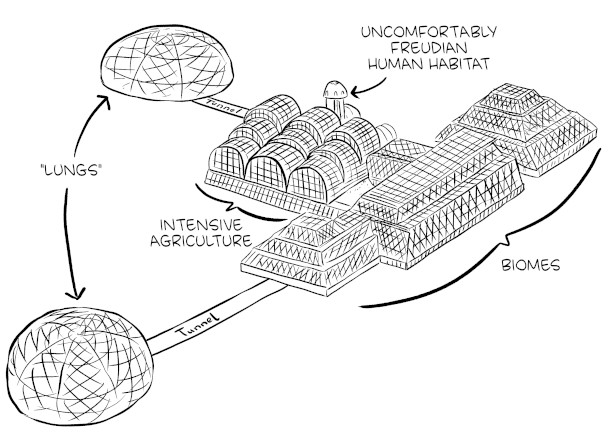
One major technological challenge for the possibility of living on Mars lies within the agricultural sector and the recycling of resources, such as plants. (Image: Drawn by Zach Weinersmith)
KELLY WEINERSMITH: So figuring out these closed loop ecosystems is going to be important. And then, because of the radiation problem, Zach talked about earlier, we're going to need to figure out how to get our habitats underground because we'll need that like dirt to protect us from the radiation. And so, figuring out how we're going to dig or cover our habitats in dirt will be difficult.
DOERING: We are going to need to eat on Mars. Why is local food essential up there? Zach?
ZACH WEINERSMITH: Well, I mean, so, you know, local food would be great, essentially, because the alternative is to ship it 10s of millions of miles through space. So ideally, what you'd want to do is build one of these closed loop ecologies that Kelly's describing, and then just recycle as much as possible. That way, you can essentially make use of the incoming energy from the sun on Mars, which is lower than on Earth, but still pretty good. And you know, one way to think about it is, we really take for granted all the stuff Earth does. Right? You don't worry most of the time that if you go outside, you're breathing something that might kill you. If you're in a sealed container, and it is going to be sealed, you really need this biosphere to be enough to cleanse everything bad while providing you tasty food and getting rid of your waste.

Sustainable agriculture and local food would be an essential part of the closed loop ecosystem while on Mars. (Image: Drawn by Zach Weinersmith)
DOERING: You know, I have to say, a lot of the food we grow here on Earth is not the most sustainably grown, and it takes a lot of resources. And I don't know how feasible that would be up on Mars. So what are some of the ideas for how we actually get enough of the nutrients that we as human beings, biological beings, need?
KELLY WEINERSMITH: This is an area that absolutely needs a lot more research to try to figure out exactly, you know, how many calories do humans need? What plants are the most reliable? How can we make sure that you have enough calories when one crop is done and the next crop is partway through its growth? These are difficult problems, but you can also imagine that this research, once we figure it out and figure out how to recycle and do this stuff more efficiently, those answers could be helpful for us here on Earth. But another problem is trying to figure out where we're going to get our protein from. So some folks that I spoke to at conferences argued that probably being a vegetarian is going to be the way to go. So our protein will come from legumes or fungi. But other folks argue that we'll have to end up getting our protein from insects. So chickens and pigs and cows, these animals are too big to bring to space. They create too much waste. They would need too much surface area, and additionally, they're not super efficient at converting the like vegetation that you give them into calories, and so you probably won't want to bring them. But if you bring insects, you can feed insects on the waste part of plants that humans don't eat, and then you can use them as a protein source. And so, in that Lunar PALACE facility that we talked about, they took the waste from the plants that the humans couldn't eat, they fed that to mealworms, and then they cooked up the mealworms as their source of protein. And we've also seen suggestions for crickets and termites and some other kinds of insects. Hopefully you don't have any wooden structures in your habitat. Probably you won't, but anyway, not a diet that sounds amazing to me, but you know, if you're hungry, anything works.
DOERING: Mm, delicious—mealworms, termites, crickets maybe I'd be okay with.
KELLY WEINERSMITH: Yeah. Our daughter has eaten crickets and liked it.
DOERING: One of the funniest and most fascinating parts of the book talked about the delicate subject of sex in space. What do we know about sex in space?
KELLY WEINERSMITH: What we have found a lot of people who have spent a lot of time thinking about sex in space, many pages written on the topic, even though there's not a lot of data to work with. So it's not clear if anyone has ever had sex in space. There are a couple of times when people propose it could have happened. There was a married couple on the shuttle that managed to go up there before NASA found out they were married. But there's no definitive evidence that anything happened. A lot of folks have tried to engineer solutions, let's say to the problem that when you push against something in space, it gets pushed back because you don't have gravity to sort of hold things down. We are fairly certain that humans will solve what we call the docking problem—
DOERING: [LAUGHS]
KELLY WEINERSMITH: But the problems that come after, including reproduction and whether or not that can happen safely, we don't have good data for that, and that's one of the things that we are most worried about in terms of space settlements.
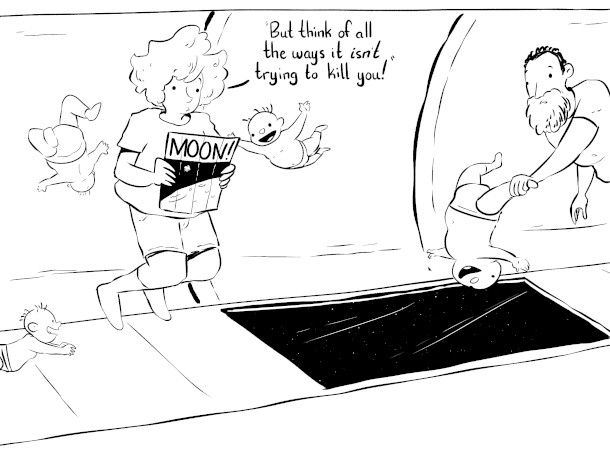
Childbirth and rearing are two of the most uncertain aspects of a potential future human expansion past our Earth. (Image: Drawn by Zach Weinersmith)
DOERING: Well, I don't think when we talk about going to space, a lot of people really think about like, envision kids, like young kids in space. We're always thinking about like Matt Damon and The Martian. You know, it's these adults on these settlements. But what are the considerations when it comes to kids and human pregnancy in space?
KELLY WEINERSMITH: Yeah. So we would say that the defining characteristic of a settlement is having children and like having families live out their days, and we just really don't know how that's going to go. So we have 50 years of data from space stations orbiting the Earth, but all those astronauts have been in free fall, so experiencing something like no gravity, and as far as we know, none of them have been pregnant, and only about 13% of the people who have been up there have even been women. So we don't even have a lot of data on female bodies in space. We also don't know how space radiation is going to impact these bodies. As Zach mentioned, these space stations are orbiting within the protection of the magnetosphere, so they're not experiencing space radiation. So we have very little data, but the data we do have are concerning. So we've sent rodents to space while pregnant, and when they come back, they need to do twice as many of a certain kind of contraction, and we think that's because their muscles get weak when they're not exposed to Earth gravity. So when they came back and went through labor on Earth, they had some problems.
DOERING: Oh, man.
KELLY WEINERSMITH: I know! I don't want to be in labor for twice as long, like it was already too long, twice as long.
DOERING: [LAUGHS]
KELLY WEINERSMITH: No, thank you. And so we also know that there's some hip problems. So astronauts lose about 1% of the density of their hip bones every month, and Mars, having 40% gravity might slow that down a little bit, but if, instead of like a couple months, you're now talking about years or developing under those conditions, is your hip going to hold up when labor kicks in? Unclear. It's also not clear that, like menstrual cycles work normally in lower gravity. There's all of these different stages that we don't understand well enough. And there hasn't even been a rodent colony that has had rodents born in space, impregnated in space, gone through pregnancy and had safe labors, and then started that cycle again. And so I feel like that's a minimum amount of data that we need, and you couldn't really get that information from the International Space Station. You'd have to maybe go to the moon and set up a research station there so that you're exposed to space radiation and lower but some gravity, and start to get a handle on things there.
DOERING: Wow, we're not there yet, it sounds like you're saying.
KELLY WEINERSMITH: No, no.
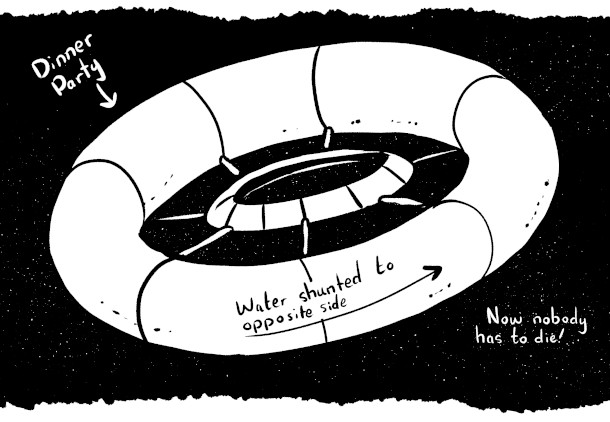
One proposed strategy for mimicking Earth gravity in the vacuum of space involves the use of something called a rotating wheel space station. (Image: Drawn by Zach Weinersmith)
DOERING: Well, and there are some solutions, potential solutions, that have been raised in terms of manufacturing gravity in space, Earth-level gravity in space. What do you think about those ideas? Zach?
ZACH WEINERSMITH: Yeah, yeah. So this idea actually goes back to the 1920s you know, the idea is, well, you don't have gravity, and maybe that's bad. But when, if you've ever been to that carnival ride where they spin you really fast, you know, you sort of stick to the wall. So that's what we mean by artificial gravity, is you spin, and then that centripetal force, forces you against a surface. And so that presumably would solve a lot of the classic medical problems of space, like diminished muscle and bone mass. And so why not do this? Especially because, you know, when it got big in the 70s, they started making all these cool pictures. Why not do this? Well, there are a number of reasons, but the deep problem is you have to just get mass from somewhere, like, stuff is not available in space. So if you're talking about a million tons, it would be expensive, right? This is like exploding 10,000 skyscrapers. So usually there's an alternative suggested. So they're basically two classic ideas, one of which is, go grab asteroids, which we haven't got into but, but like, basically would be we don't have the technology yet, and when we do, it will be quite expensive. And then, mind you, of course, then you have to catch the asteroid and convert it to suburbs, which is often sort of glossed over. And then you could set up what's called a mass driver. If you want to visualize a mass driver, imagine there is like a maglev train, like a train that floats on magnets, and the track goes along the lunar surface, then goes up and then just ends. And so you put a train on that with, like a cargo, it flies up and shoots its cargo into space where it's caught by literally, a sort of giant space catcher's mitt, where, again, it is somehow converted into orbital suburbs. That's hard enough. Add in that building a rotating space object is actually tricky because you're putting fairly large forces on this object. We call it the washing machine problem, which is, if you've ever, like, put towels in wrong in a washing machine, halfway through the cycle, you hear it going kachunk, kachunk, kachunk.
DOERING: Oh yeah.
ZACH WEINERSMITH: Because it's unbalanced, right? Yeah. And so this can be solved. The usual solution is something like, you have hydraulics, which you know, if everybody's on one side of the station to watch a Taylor Swift concert, you shift a bunch of water down the other side of the wheel so that it counterbalances all the Swifties. So this is doable, but you see how it's a little terrifying, and if it goes wrong, you know the concert gets opened to the void. To sum up, these are cool. They are space settlement on extreme hard mode.
Related links:
- Purchase a copy of A City on Mars (Affiliate link supports Living on Earth and local bookstores)
- Kelly Weinersmith’s website
- Zach Weinersmith’s website
[MUSIC: Gustav Holst, Berliner Philharmoniker, Herbert von Karajan, “The Planets, Op. 32: III. Mercury, the Winged Messenger, Deutsche Grammophon GmbH, Berlin]
DOERING: We’re speaking with Zach and Kelly Weinersmith about their book A City on Mars: Can We Settle Space, Should We Settle Space, and Have We Really Thought This Through? And we’ll be right back with more. Stay tuned to Living on Earth!
ANNOUNCER: Support for Living on Earth comes from the estate of Rosamund Stone Zander - celebrated painter, environmentalist, and author of The Art of Possibility – who inspired others to see the profound interconnectedness of all living things, and to act with courage and creativity on behalf of our planet. Support also comes from Sailors for the Sea and Oceana. Helping boaters race clean, sail green and protect the seas they love. More information @sailorsforthesea.org.
[CUTAWAY MUSIC: Gustav Holst, Berliner Philharmoniker, Herbert von Karajan, “The Planets, Op. 32: II. Venus, the Bringer of Peace, Deutsche Grammophon GmbH, Berlin]
A City on Mars and the Perils of Settling Space (Cont'd)

Space exploration could set the stage for territorial conflicts. (Image: Drawn by Zach Weinersmith)
O’NEILL: It’s Living on Earth, I’m Aynsley O’Neill.
DOERING: And I’m Jenni Doering. And we’re back now with Zach and Kelly Weinersmith, authors of A City on Mars: Can We Settle Space, Should We Settle Space, and Have We Really Thought This Through? And, Kelly, I gather something that space settlement enthusiasts should probably “think through” a little more has to do with the law. So, why did you feel that it was important to cover international space law in this book?
KELLY WEINERSMITH: Doesn't “space lawyer” sound like the job in a science fiction novel? Like it took me forever to be like, "Oh, this is a real field." But, I mean, it's a field that could get in the way of space settlement dreams. So for example, Elon Musk would like to see a million people on the surface of Mars in a self-sustaining settlement in the next 20 to 30 years. And his company Starlink, which is his satellite internet company, in their terms of service, it says something to the effect of, when humans get to Mars, they will not be beholden to the government of Earth. So he would like to start it sounds like his own nation, and that straightforwardly breaks international law. So in 1967 a treaty was ratified through the United Nations. That's now called the Outer Space Treaty. And it has a lot of important stuff in it, like, you can't put nuclear weapons in space.
DOERING: Good idea.
KELLY WEINERSMITH: Yeah, I, totally behind that, because at the time, we were setting off a lot of nuclear weapons in space, and it was causing problems and making people very nervous, as you can imagine.
DOERING: Yeah.
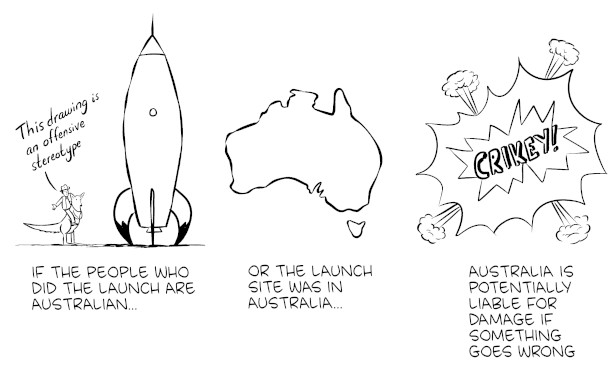
The Outer Space Treaty states that the supervising nation is legally responsible for both governmental and non-governmental activities in outer space. (Image: Drawn by Zach Weinersmith)
KELLY WEINERSMITH: Yeah. And another part of it says that you're not allowed to claim sovereignty over anything in space. So when we landed astronauts on the moon, and they put down an American flag, that was not claiming that the moon is ours, that was just like a symbolic, uplifting act. But it sounds like Musk would like to be able to claim something as their own, or something as the ownership of whoever goes out there, like the first group of Martians. But the Outer Space Treaty also says that well, according to international law, anyone who goes to space is the responsibility of some nation, and so if SpaceX sends a bunch of people to space, they will probably be the responsibility of the United States, which means they really can't be starting their own nation in space and claiming that territory as their own.
DOERING: Until reading your book, Kelly and Zach, I had no idea that there is special primo real estate on the Moon. Why is that?
KELLY WEINERSMITH: So the Moon is a particularly horrible place to be. So at the equator, I think it swings from something like negative 130 degrees Celsius to positive 120 degrees Celsius, whether it's day or nighttime. So that's a swing of 250 degrees Celsius that will kill you with cold or kill you with heat in either direction that you're in. Additionally, it's got that regolith, so that very abrasive fine dust, and so there's some concern that if you breathe it in, it's going to scar your lungs and cause stone grinders disease, just a very harsh environment, and the regolith has a little bit of water in it. But technically, that's also true of concrete. But concrete is wetter than the regolith.
DOERING: We're talking dry concrete.
KELLY WEINERSMITH: Yeah, very dry concrete, yeah. And so if you want water on the moon, you have to go to the poles. And in the poles, there are these craters, and inside the craters there's water trapped as ice, and it's so cold that it's like rock, but it's still there, and it's contaminated. It'll need to get cleaned up, but there's water there. And those craters are also important because the rims of the craters would be great places to set up solar panels. So if you are at the equator, you have a period of time that's equivalent to two weeks here on Earth where you're in total darkness. So their nights are really long, and the number of battery packs that you would need to bring with you is prohibitive. So we're probably not going to be relying on solar power at the equator.
DOERING: That's a long, cold night. Two weeks.
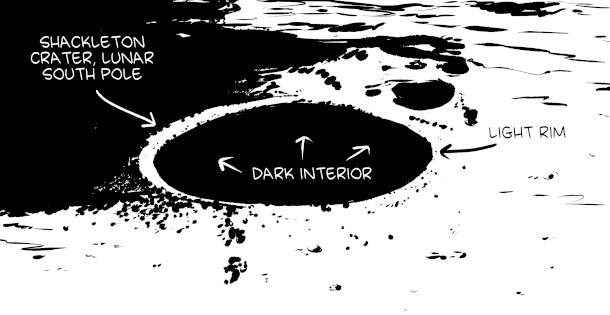
The light rims found on the edge of the craters on the Moon would be ideal places to put up solar panels (Image: Drawn by Zach Weinersmith)
KELLY WEINERSMITH: A really long, cold night followed by a blisteringly hot day. But if you're at the poles, the temperature swings are way less extreme. And because of the way that the moon is tilted, if you're on some of those rims, you can get sunlight almost all the time. So they're called the peaks of eternal light, and they should probably be called the like peaks of almost sort of eternal light, because you get it like 93% of the time. But that's much better. And so you can set up solar panels there and have a reliable source of power. And then you're next to these craters of eternal darkness, which is where you get the water. And so most of the proposals from NASA or the Chinese space program that talk about where they want to, like, set up research stations or land and think about staying for a while. You're looking at the poles, and this is a very small surface area of the Moon. And so we are set up for a scramble for the best parts of the Moon because the Moon kind of all looks the same, but you definitely just want to go to the poles.
DOERING: You know, given that some of the most powerful and wealthy people in the world, we're talking Elon Musk, Jeff Bezos, not to mention rival nations, have a keen interest in sticking a claim in space, whether or not that's legal, how hopeful are you that International Space Law can, like, reign in the most dangerous impulses here to just go out and use up resources and take control?
KELLY WEINERSMITH: We're a little nervous. I think it would maybe be an understatement. So you know, one of the problems is uncertainty. So you can't go out and say, "This is mine." But for example, if the United States or China got to the poles of the Moon, where you can find some water, if they got there first, there's nothing stopping them from setting up on what is arguably the best part of the Moon and then saying, "Okay, it's not safe to come in this area, because I'm working on some stuff. And if you land your rocket, you're going to hit me with debris, and that could be bad for my people. So nobody else is allowed in this area. And I'm not saying that it belongs to me, but I also don't plan on ever leaving." And that's sort of quasi sovereignty. It certainly feels like sovereignty. So I would love to see more clarity for international law. And you asked how optimistic I am that we're going to get that. There's reasons to be optimistic. It does seem like we're getting clarity on the resource question we talked about already. So the Artemis Accords came out through NASA in 2020, a lot of nations have signed, and that does essentially say we all agree that it's okay to go out and extract resources and sell them, and that we're all cool with that. So like, a consensus does seem to be building there, but no treaties have been ratified that bind the behavior of the major space players through the United Nations in like 50 years, and so I'm not optimistic that we'll get a treaty to solve these problems.
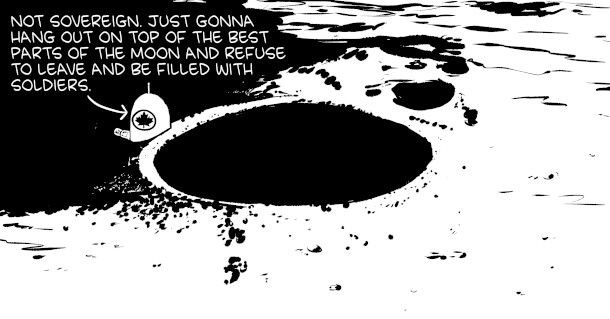
A “quasi-sovereignty” could hypothetically be set up at one of the poles of the Moon without directly being claimed. (Image: Drawn by Zach Weinersmith)
DOERING: So Kelly, Zach, as a couple, what was it like writing A City on Mars together?
ZACH WEINERSMITH: You gonna let me have that one? [LAUGHS]
KELLY WEINERSMITH: Well, I'll get my say. You can start.
ZACH WEINERSMITH: Well, all right, good. Good. Good. Disappointingly non-dramatic. I kind of wish someone threw a chair through a window at some point, just so we can report it.
KELLY WEINERSMITH: [LAUGHS]
DOERING: [LAUGHS]
ZACH WEINERSMITH: No, I mean, you know, our last book, Soonish , we kind of just say, "Well, you do a chapter and I'll do a chapter, and then we'll come together." For this, we kind of had to, like, divide and conquer according to aptitude. So like, our joke was, you know, Zach reads very quickly with about 80% comprehension. Kelly reads very slowly with 100% comprehension. So essentially, like, I was vanguarding into, like, I'm gonna read a bunch of astronaut memoirs, and I'm gonna read all these, like, old books about the space future and this and that, and Kelly was often the one with the task of, like, NASA has 150 pages on the effects of radiation, with like, 8 billion citations. Kelly's going to read the whole damn thing. Essentially, the workflow we ended up with was we would both research and then we dropped these into a giant pile of notes in Google Docs. We like, literally have 1000s of pages of notes on all these different topics, and then Kelly, for a given chapter, would collate all of those notes and then create something we call the dossier, which is was a sort of like 30-page version of something that needed to be five or six pages with suggestions of structure and, like high points and quotations that might be amusing. And then my job was to kind of swoop in at the end and make it a little funny and jaunty, and then endless rewrites. But essentially, you know, we had to, like, play to our strengths because there was no way to get it across the finish line, otherwise. In terms of us not yelling at each other, I think the main thing we had going for us is that we really just cared a lot about this project. This wasn't just like a meal ticket for us. We spent, like, a decent amount of our careers on this. And so, like, the part where your spouse is like, "I think you wrote this badly, and you should start over." What you want to do is say... Well, I don't want to say. But, but what you do is you say, "All right, fine. I will because as much as I don't want you to tell me I suck, I really don't want the world to tell me I suck." And so we would go back and rewrite together, and no one had to die.
KELLY WEINERSMITH: [LAUGHS]
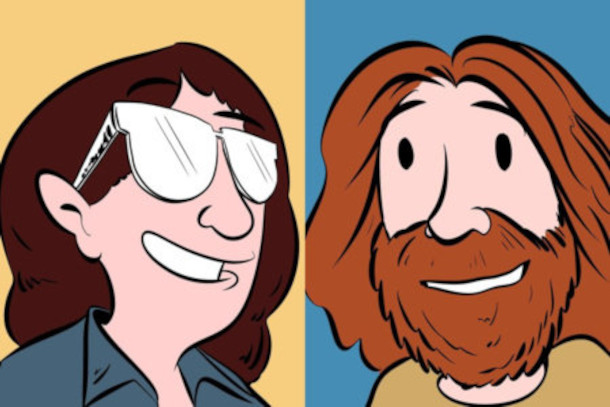
Zach’s rendering of Kelly and himself. (Image: Drawn by Zach Weinersmith)
DOERING: [LAUGHS] And Kelly, what was it like for you, and if I may, how did it change your relationship?
KELLY WEINERSMITH: You know, I think Zach did a really good job of describing what the experience was like. There were so many instances where I would send a draft of the chapter to Zach and he'd be like, "What? No, this is all wrong." And then he'd send me a draft of the chapter, and I'd be like, "Are you kidding me? This is all wrong." And I think we both eventually got good at accepting that particular kind of criticism. I don't feel like that has translated into like, "Oh, you didn't do the laundry."
KELLY WEINERSMITH: Somehow that still hurts—
ZACH WEINERSMITH: [LAUGHS]
KELLY WEINERSMITH: —you know, when it comes from either of us, but when it comes to like, "This writing isn't quite working," we've managed to sort of scrape our egos out of the equation. And we'd focus on, "All right. Well, we need to get the best version of this done." And we got pretty good at accepting each other's criticism when it comes to writing over the course of the four years.
ZACH WEINERSMITH: But there was, there was the one fight.
KELLY WEINERSMITH: There was... no, there were two fights.
ZACH WEINERSMITH: You know what I'm talking about.
KELLY WEINERSMITH: There were two fights.
ZACH WEINERSMITH: What were the two fights?
KELLY WEINERSMITH: Google Docs versus Word—
ZACH WEINERSMITH: [LAUGHS]
KELLY WEINERSMITH: —and has sex ever happened in space? We came down on very different sides of that argument.
DOERING: [LAUGHS] All right, so we got to settle this. Which one of you thinks sex has happened in space and which one of you does not?
KELLY WEINERSMITH: I think it has.
ZACH WEINERSMITH: I mean, all right, listen, my wife's mind is in the gutter about this.
DOERING: [LAUGHS]
ZACH WEINERSMITH: I think the problem is, all right, you can't just sort of, like, take the amount of time and multiply through because otherwise, you would have to apply this logic to every place that's ever existed. Like, like, has anyone had an excursion in the like, containment chamber of Chernobyl? Well, it's been there a while. Okay, okay. You think that's happened too, never mind. But the bigger issue is, like...
KELLY WEINERSMITH: [LAUGHS] Are you retreating already?
ZACH WEINERSMITH: It's easy to say... What?
KELLY WEINERSMITH: It feels like you're retreating. Go ahead. [LAUGHS]
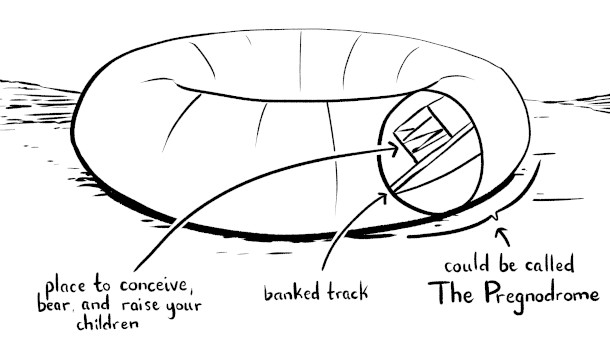
The particulars of human reproduction in lower-gravity environments than Earth require further scientific study to be fully understood. (Image: Drawn by Zach Weinersmith)
ZACH WEINERSMITH: [LAUGHS] No. Okay. But listen, you're working in theory. I'm working in practice. You could say it's been a long time with lots of people but you cannot pinpoint where it could possibly have happened. You know, you want to talk about what was it Jan and Mark Davis, who were newlyweds, and they go up in the space shuttle, but the space shuttle has the living space of a bus, and there are seven people in it, and so they have, like, a week and a half to make it happen. So the only possible opportunity is for there to be a seven-person space sex conspiracy that hasn't been revealed for 30 years. And I just don't believe it.
KELLY WEINERSMITH: I am surprised by your lack of creativity, and I will point out that an absence of evidence isn't evidence of absence. So anyway, we'll let it go now.
ZACH WEINERSMITH: Yeah. All right. [LAUGHS]
DOERING: All right. So still a mystery.
KELLY WENERSMITH: [LAUGHS]
DOERING: Now, so Zach, one of the things I haven't really asked you too much about yet is all the wonderful cartoons in this book. There's a lot of unique things about this book, but they make it really fun. So what was that like, taking the material, making sure that you're communicating the information, but also then being able to make cartoons about it?
ZACH WEINERSMITH: Yeah, so you know our view of pop science is that, essentially, you're trying to take something big and make it palatable for a general audience. And you can either water it down enough that people will roll with it, or you can at least try to give people the real thing, but put enough sugar on it that it'll go down. I think that actually can be non-trivial. Like if you're talking about something complicated, and you tell a joke, the audience relaxes and can say, "Okay, maybe it's not that hard to understand." To be frank, the most boring thing was international law to research. Not that there weren't like occasional oases of funny stuff. I mean, it's thick and it's written by lawyers. It was just very hard. And so trying to take that and say, "How do we go to a normal audience and make this interesting? Because we think it's important. It's part of the picture. It's almost always skipped." You basically have all the most powerful nations on Earth saying how they feel on paper. You have to understand this. And unfortunately, it exists in a whole milieu of history which you kind of have to understand. So it was like, how do we make this palatable? So, like, there's a comic, and it's one of the few comics that really doesn't add anything intellectual, but it's just...we discovered this anecdote that actually happened where the Nazis tried to claim a chunk of Antarctica, and literally, at one point this is documented, they came out and heiled a penguin. I think it was an emperor penguin. And I remember reading that and being like, "This is going to get us through how does Antarctic treaty law work." Generally speaking, most of the illustrations actually provide a kind of diagram or an intellectual addition to the topic, but a lot of them are just there to get you through it, to say, like, "Come along with me. I'll tell you a few jokes and stories. I'm sorry you have to understand this." So that was the approach.
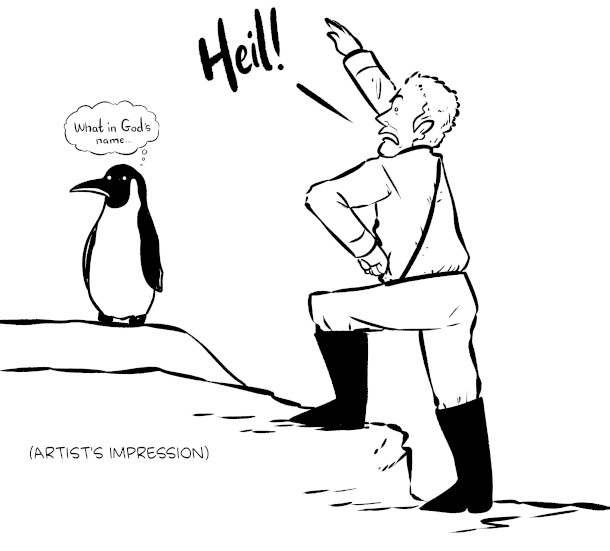
In the process of the Nazis trying to claim a chunk of Antarctica, they 'heil’ed a penguin. (Image: Drawn by Zach Weinersmith)
KELLY WEINERSMITH: And our editor is such a saint, because she was like, "How many chapters on how international law applies to space do you want to write?" And we're like, "Five?" And she was like, "You guys better be really funny." [LAUGHS]
ZACH WEINERSMITH: [LAUGHS]
DOERING: I think when people envision humans going out into space, sometimes there's this idea that we're just going to be like, better people up there were going to be different. What do you make of that idea?
KELLY WEINERSMITH: So you're referring to an idea put forward by philosopher Frank White, and it's called the overview effect. And the idea is that viewing Earth from space has a bundle of goods, some of them being you know, you decide that borders don't really exist, and we should all be getting along, and that the Earth is this fragile system that we need to take better care of. And it's a beautiful idea, but we haven't found much evidence for it, either in the literature or in the memoirs that we read. So one, it's worth noting that you can see borders from space. You can see the border between India and Pakistan that's lit up. There's a lot of conflict there. You can see the border between South Korea and North Korea because North Korea is dark at night and South Korea is not. So our problems are, in fact, visible from space. And the many astronaut memoirs that we read, they would come back from space, and they would still be humans. You know, they would still cheat and lie and you know, they're way better people than Zach and I are in a lot of ways, but they're still human beings. I think we're human beings on Earth, and we're going to be human beings in space. We're going to bring our problems with us, and I think you need to be clear-eyed about that.
ZACH WEINERSMITH: This pertains to, we will not be angels in space. So this happened in 1975. Most people don't remember. It was called the Apollo-Soyuz Test Project. And the very short version is it was the first time the US and the Soviets docked together in space. And so you might think this is the perfect place to say, "You see, in space we transcend, and we are better than ourselves." Well, John Young wrote about this in his memoir. He's an astronaut's astronaut. He was one of the Apollo guys. He was one of the pilots of the first space shuttle. He wrote about how there was a dispute on Apollo-Soyuz Test Project over who was going to be which part of the dock. And as he put it, "Nobody wanted to be the one getting the business." This was a non-trivial dispute. Apparently cost a huge amount of money. By the end, they had to create an androgynous docking system because they couldn't agree to who got to be the boy and who got to be the girl. Okay, so this idea that we're going to stop being humans in space is just absurd. In addition to there being no evidence for it, there's tons of evidence against it.
DOERING: That's such an interesting reflection, too, on gender dynamics. And, you know, I imagine nobody wanted to be the so-called female end. [LAUGHS]
KELLY WEINERSMITH: That's right, yes.
DOERING: Yeah.
KELLY WEINERSMITH: It was the female end nobody wanted to be, yeah. Well, and the first woman to step foot on a space station was handed an apron. And so yes, our gender issues follow us to space as well.
ZACH WEINERSMITH: Yes.
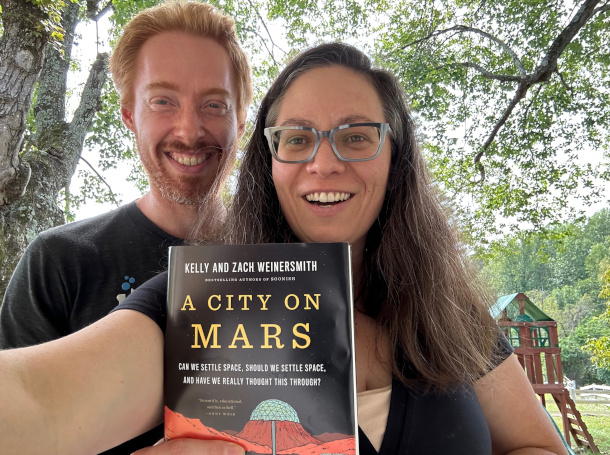
Zach and Kelly Weinersmith pose with a copy of A City on Mars. (Photo: Courtesy of Zach and Kelly Weinersmith)
DOERING: Well, what do you hope that readers take away from this book?
KELLY WEINERSMITH: So we try not to be wet blankets, literally 100% of the time. So the uplifting message we like to send is that there's a lot of cool work that needs to be done. There's a lot of really awesome research projects. There's a lot of really important international law. And I mean, if you're in international law right now, you could be helping to establish the rules that guide humans as we move through the cosmos. Like, that's an amazing job to be involved with. And the scientists who get to run a research station on the moon to look at rodent reproduction, like that sounds really cool to me. And, you know, trying to figure out these closed loop ecosystems, figuring out how to recycle resources better, that could help Earth. Like there's so many cool questions with so many cool side projects that I think getting excited about being part of the generation, or generations, that get us ready for settling space is worth being excited about, even if I don't think we'll be settling space within my generation. I had to end on a, you know, sort of negative point because that's who I am. [LAUGHS]
ZACH WEINERSMITH: [LAUGHS] It's what you do.
DOERING: And Zach, any final thoughts?
ZACH WEINERSMITH: Oh, well, just to echo Kelly. I mean, I think often in science, there's a kind of like, hype pop version of things that sounds really cool, but often, you know, the truth is often much more interesting than the hype version. It just takes a little effort to understand it. And so I worry there have been a lot of people who like, feel like they're on our side, who go on the internet and are like, "According to Kelly and Zach, you will never colonize space, so stop trying." We don't say that! Never is a long time. And in fact, we provide a roadmap at the end to the stuff you'd need to do. And it's all amazing. So we think it can happen, and we are in no position to predict the future. So even if we never do this, or none of us live to see it happen, all the stuff we do in the interim is amazing.
DOERING: Zach and Kelly Weinersmith are the co-authors of A City on Mars: Can We Settle Space? Should We Settle Space? And Have We Really Thought This Through? Thank you both so much. This has been really fun.
KELLY WEINERSMITH: Thanks. We had a blast.
ZACH WEINERSMITH: Yeah, thanks for letting me argue with my wife about sex on the radio. That was...[LAUGHS]
DOERING: [LAUGHS]
KELLY WEINERSMITH: [LAUGHS] Highlight of the marriage!
ZACH WEINERSMITH: [LAUGHS]
Related links:
- Purchase a copy of A City on Mars (Affiliate link supports Living on Earth and local bookstores)
- Kelly Weinersmith’s website
- Zach Weinersmith’s website
[MUSIC: Gustav Holst, Berliner Philharmoniker, Herbert von Karajan, “The Planets, Op. 32: II. Venus, the Bringer of Peace, Deutsche Grammophon GmbH, Berlin]
O’NEILL: Living on Earth is produced by the World Media Foundation. Our crew includes Naomi Arenberg, Paloma Beltran, Sophie Bokor, Daniela Faria, Swayam Gagneja, Mark Kausch, Mark Seth Lender, Don Lyan, Ashanti Mclean, Nana Mohammed, Sophia Pandelidis, Jade Poli, Jake Rego, Andrew Skerritt, Bella Smith, Melba Torres, and El Wilson.
DOERING: Tom Tiger engineered our show. Alison Lirish Dean composed our themes. And we always welcome your feedback at comments@loe.org. Steve Curwood is our Executive Producer. I’m Jenni Doering.
O’NEILL: And I’m Aynsley O’Neill. Thanks for listening, and Happy New Year!
ANNOUNCER: Funding for Living on Earth comes from you, our listeners, and from the University of Massachusetts, Boston, in association with its School for the Environment, developing the next generation of environmental leaders. And from the Grantham Foundation for the protection of the environment, supporting strategic communications and collaboration in solving the world’s most pressing environmental problems.
ANNOUNCER 2: PRX.
Living on Earth wants to hear from you!
Living on Earth
62 Calef Highway, Suite 212
Lee, NH 03861
Telephone: 617-287-4121
E-mail: comments@loe.org
Newsletter [Click here]
Donate to Living on Earth!
Living on Earth is an independent media program and relies entirely on contributions from listeners and institutions supporting public service. Please donate now to preserve an independent environmental voice.
NewsletterLiving on Earth offers a weekly delivery of the show's rundown to your mailbox. Sign up for our newsletter today!
 Sailors For The Sea: Be the change you want to sea.
Sailors For The Sea: Be the change you want to sea.
 The Grantham Foundation for the Protection of the Environment: Committed to protecting and improving the health of the global environment.
The Grantham Foundation for the Protection of the Environment: Committed to protecting and improving the health of the global environment.
 Contribute to Living on Earth and receive, as our gift to you, an archival print of one of Mark Seth Lender's extraordinary wildlife photographs. Follow the link to see Mark's current collection of photographs.
Contribute to Living on Earth and receive, as our gift to you, an archival print of one of Mark Seth Lender's extraordinary wildlife photographs. Follow the link to see Mark's current collection of photographs.
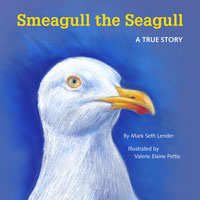 Buy a signed copy of Mark Seth Lender's book Smeagull the Seagull & support Living on Earth
Buy a signed copy of Mark Seth Lender's book Smeagull the Seagull & support Living on Earth

